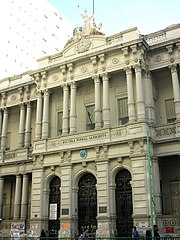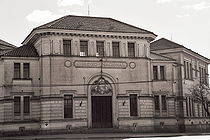Education in Argentina
Education in Argentina is a responsibility shared by the national government, the provinces and federal district and private institutions.
[3] There was no effective education plan until President Domingo Sarmiento (1868–1874) placed emphasis on bringing Argentina up-to-date with practices in developed countries.
Sarmiento encouraged the immigration and settling of European educators and built schools and public libraries throughout the country, in a program that doubled the enrollment of students during his term.
The non-religious character of this system, which forbade parochial schools from issuing official degrees directly but only through a public university, harmed the relations between the Argentine State and the Catholic Church, leading to resistance from the local clergy and a heated conflict with the Holy See (through the Papal Nuncio).
Aramburu's Law 6403 of 1955, which advanced private education generally, and parochial, or more often, Catholic-run schools (those staffed with lay teachers), in particular, helped lead to the establishment of the Argentine Catholic University.
The policy's weakness, however, lay in that federal revenue sharing did not increase accordingly, particularly given the decision to shift two primary school years to the secondary system.
[5] Real government spending on education increased steadily from the return of democratic rule in 1983 (with the exception of the crises in 1989 and 2002) and, in 2007, totaled over US$14 billion.
Up to 2013 Argentina educated five Nobel Prize winners, three in the sciences: Luis Federico Leloir, Bernardo Houssay and César Milstein and two in peace: Carlos Saavedra Lamas and Adolfo Pérez Esquivel, the highest number surpassing countries economically more developed and populated as Ireland or Spain.
Around 11.4 million people were enrolled in formal education of some kind in 2005: 1 excludes 185,776 teachers not classified by level [13] The scale to grade up the academic performance in students at most of the primary and secondary schools rests in the 1-10 ladder as is described in the following frame.
As of the start of the 2019 school year, in 16 out of 24 jurisdictions (23 provinces + the Autonomous City of Buenos Aires), 6 is the minimum passing grade, while in the others is 7.
In addition an adult system of high schools (usually called Acelerados, Spanish for accelerated) exists in order to guarantee secondary education to people over 18.
Argentina's network of vocational schools, many under the auspices of the National Technological University (UTN) or the provincial educational systems, have historically given students viable alternatives, as well.
Although it is not required to pay any kind of fee at universities, hidden costs of education, like transportation and materials, are often neglected.
[13] Summing up, over 1.5 million students attend institutions of higher learning in Argentina, annually (roughly half the population of college age).
[21] In April 2024, tens of thousands of people took to the streets in Argentina's capital Buenos Aires to demand increased funding for public universities.
The doctoral studies offered by the Argentine universities include multiple fields and do have national and international validity of the degrees granted.
This entity stands as a public and decentralized body working under the jurisdiction of the Department of Education, Science and Technology.




